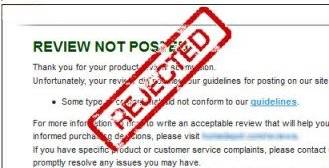The Do’s and Don’ts of Managing Customer Comments.
Many companies are now using social media, open review forms and other public-facing forums to collect feedback from their customers. This can be a good thing and it impacts consumer opinions. I have often referred to others’ comments when making a purchase.
Good customer feedback always has a positive effect, as long as it’s believable. I have to believe the testimonials or comments are from real customers or I’ll just discount them. That’s true for most users, and most people are savvy enough to tell the difference between actual customer comments and made-up testimonials.
Negative feedback can sometimes be a deterrent and can cause a loss of business, but it doesn’t have to be that way. For one, there is always someone with a negative comment. Everyone knows that and most people will take such comments with a grain of salt. Additionally, a few negative comments can add to your credibility. Users know you’re not managing every comment and it can make the positive comments look more believable.
Negative feedback also provides an opportunity. You have a chance to address the comment and solve the customer’s problem. Solving the problem publically via a forum or social media outlet can not only win back one disgruntled customer, it also demonstrates to potential customers that you respond to concerns and will be there for them if they have an issue.
 This issue really came to light for me when Home Depot mismanaged its feedback mechanism when I was making an online purchase. About a month later I got a survey request, “How did you like our products?” Two of them I liked. I gave them rave reviews. One product, however, had not worked out, and I gave that an honest review describing the problems I’d had. I felt good about participating and making my voice heard. I’d also warned other shoppers about some potential problems. It was a very positive experience . . . until Home Depot made a major mistake.
This issue really came to light for me when Home Depot mismanaged its feedback mechanism when I was making an online purchase. About a month later I got a survey request, “How did you like our products?” Two of them I liked. I gave them rave reviews. One product, however, had not worked out, and I gave that an honest review describing the problems I’d had. I felt good about participating and making my voice heard. I’d also warned other shoppers about some potential problems. It was a very positive experience . . . until Home Depot made a major mistake.
About a week after submitting my reviews I got three emails: 1) Thank you for your comments; 2) Thank you for your comments; and 3) Your comments were rejected (of course, we all know which comment that was).
So what impact did this have on my opinion of Home Depot? 1) Their comments are censored and thus, not credible; 2) They don’t care about me or my problems and didn’t try to solve anything; 3) I don’t trust Home Depot – and I’ll definitely consider taking my business elsewhere in the future.
This is a perfect example of how customer feedback forums can go wrong. If you want to avoid that, here are a few simple Do’s and Don’ts:
- Do provide a forum for your customers to give their feedback.
- Do accept all customer feedback, good or bad (barring the ridiculous or profane).
- Do respond to negative feedback and do whatever it takes to turn it positive.
- Don’t reject comments you don’t like.
- Don’t salt your comments with false positive feedback.
- Don’t discount or discredit negative comments; engage your customers and solve the problem.
Allowing open customer comments is a positive thing and it’s something many businesses should consider. It can make your customers feel engaged in the process and make them feel that their voices are heard. Properly managing negative comments can make you look responsive and conscientious. However, you must stay on top of it. You must respond, and you must be honest. Any hint of deceitful practices or censorship will be detected and the damage can be irreparable.
Do you use customer feedback tools? Do you trust the reviews you read? Let us know.








